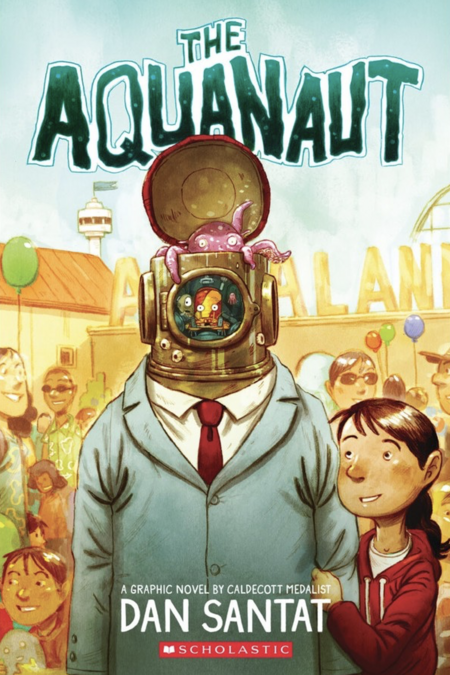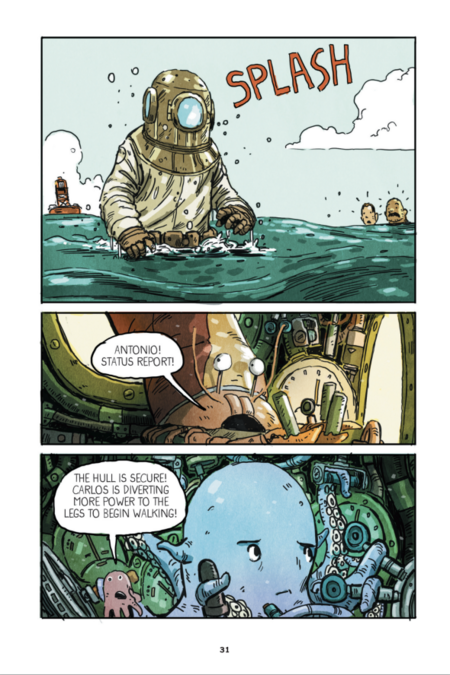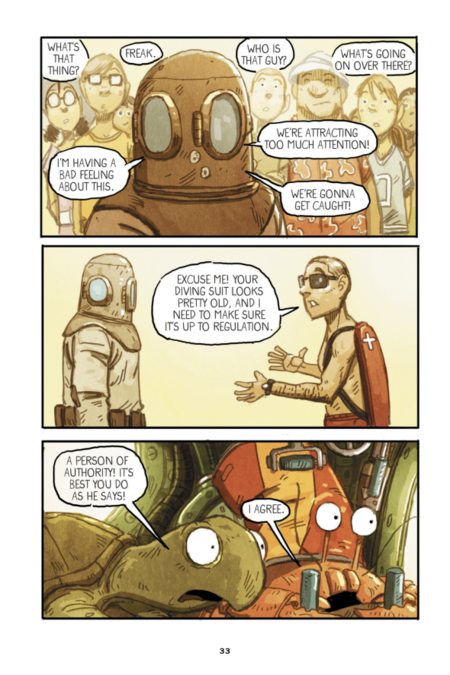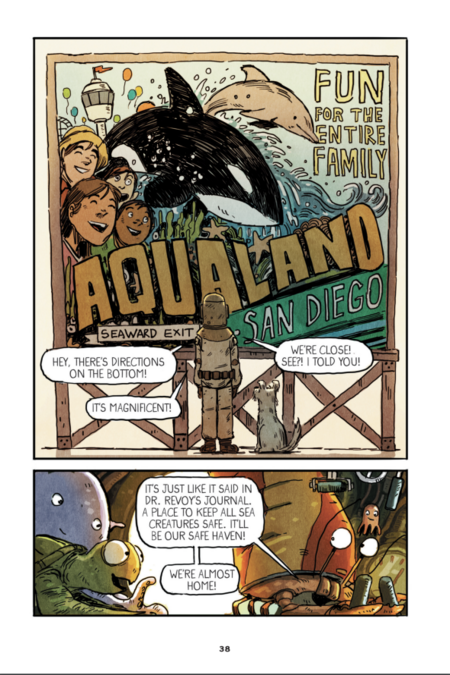Ask anyone who knows me and they will say, hand on heart, that what I love most of all when it comes to storytelling is a quirky premise, something that dances with alacrity and glee a little, or a lot left of centre, and which is gentle surreality and heartwarmingly odd.
Even better, of course, is when said quirky story comes with enough heartfelt meaning to sink an unfeeling battleship; give that heady mix of quirky and humanity and I am there in every way it is possible to be, likely yesterday before you even told me, so keen am I for that sort of narrative.
All of that to say, and yes a lot was said to make a fairly simple point, that for that reason I love, LOVE, The Aquanaut, a graphic novel by Dan Santat, which comes with an ostensibly goofy story of a bunch of sea creatures that climb onto land in an old diving suit seeking a home at a place called Marineland which they have been led to believe is a place of sanctuary for the ocean dwellers where they will be safe.
How did they find out about this place which is located in San Diego, home of places aquatic, and sometimes controversial?
Why from the diary of Captain Michel Revoy, Jacques Cousteau red beanie and all, who, very sadly in a prologue, goes down with his research vessel Miette in a storm, unable to escape the cabin in which he’s trapped, and sending most of the work he has done to the ocean floor.
He is survived by his brother Paul, and the rest of the crew, who escape, though they are naturally traumatised by the loss of Michel, a grievous blow that sees Paul become obsessed with keeping he and his brother’s shared legacy of love for the aquatic world alive, even at the expense of caring for his niece, Michel’s young daughter, Sophia, who’s surrounded by love but rather deficient in focused familial love.
So, already in the short opening series of pages we have oddball and raw, pain-filled humanity bound tightly together in a story that offers so much to readers of any age.
It is, being a Scholastic book, targeted as a younger demographic, but honestly, there is such insightful richness in The Aquanaut, not to mention goofy playfulness and artwork so sublimely lovely that you will want to dive into it (appropriate given the setting and subject matter), that anyone who has ever experiencing the searing pain of losing a loved one will gravitate to the enormous of heart that suffuses ever last panel in this wondrous story.
Having suffered the deaths of both parents, there is much for someone like me to gravitate to in The Aquanaut, not least because the author and artist himself endured the death of his father during the production of the graphic novel, saying in a note at the back of the book that “my own father lost his battle to liver cancer, and I suddenly found myself feeling all the feelings that these characters were experiencing in the story, and the project became even more personal.”
Now, he doesn’t make it clear if any changes were made to The Aquanaut subsequent to his dad’s passing, but I suspect that even without that terrible event, that Santat would have informed the story with empathetic truthfulness and wonder because everything about the story suggests a creative soul who understands humanity and its vagarious twists and turns well and who knows to turn it into wholly compelling and comprehensively affecting storytelling.
Santat admits in his end of book note that The Aquanaut is a story “about loss, preserving legacies, family, and holding onto memories” and this thematic focus is beautifully evident throughout the book which affirms at every step how important belonging and love and how their absence can searingly affect a person.
What The Aquanaut also does with joyously offbeat wonderfulness is just have very silly fun with its premise.
By any marker, the sea creatures who animate Michel’s old diving suit are gleefully offbeat, a found family of sorts composed of a crab who lives in a soda pop can – and who is thus known, with gorgeous simplicity and prosaic sensibleness as Sodapop – an octopus known as Carlos, a Kemp’s Ridley Sea Turtle called Jobim and a Blanket Octopus known as Antonio, with all three of the latter inhabitants of the diving suit, which gives a happily uplifting Shaun the Sheep level of whimsy, named, rather delightfully, after the famous Brazilian composer Antônio Carlos Jobim.
They are so much fun to read about together, strangers in a very strange land they refer to as “space” – given the absence of water, the name makes absolutely perfect sense – who have to figure out how to act like a normal person (they fail in the end but good lord it’s a joy watching them try to be human with only one man’s notes as a guide) and who, when they discover Marineland’s previously idealistic intent has been compromised by the Revoys’ greedy backers, have to figure out how to free the inmates of this watery prison.
Bonding with Sophia, and later with Paul who goes on his own unique journey of grief and healing to reawaken to the need to be there for his niece, the creatures of the diving suit are both ecological warriors and also representative of anyone who goes looking for salvation elsewhere, doesn’t find it and has to figure out what to do next.
What they do next, all told with beautifully drawn, emotionally evocative and scene-amplifying artwork that is both cute and confrontingly hard all at once, makes The Aquanaut an absolutely quirky joy to read, a tale that is goofy, silly and fun on one thoroughly entertaining level, but also insightfully real and honest about how grief can consume and how, when we least expect, the most unusual things can put us on the road to healing.



